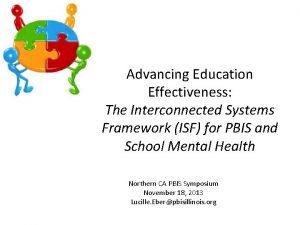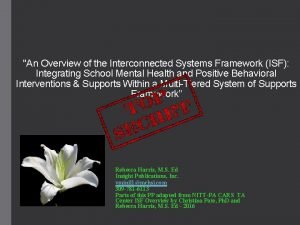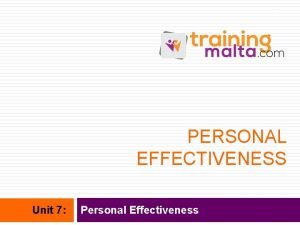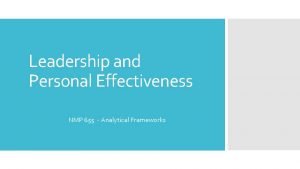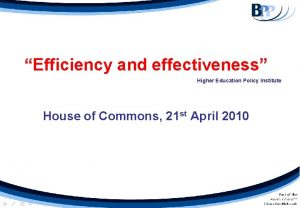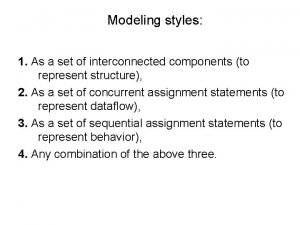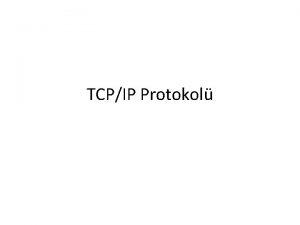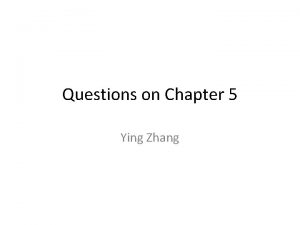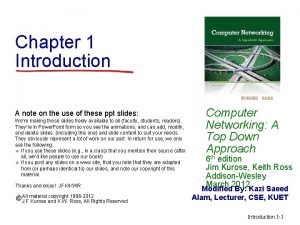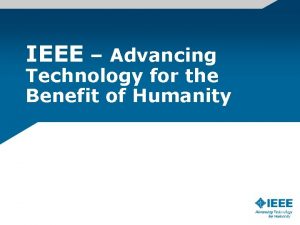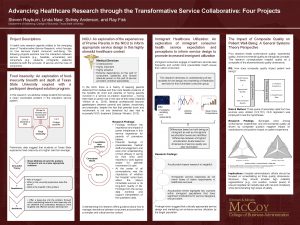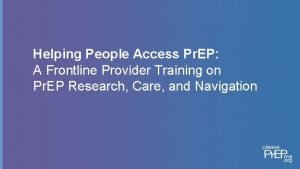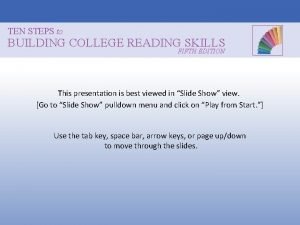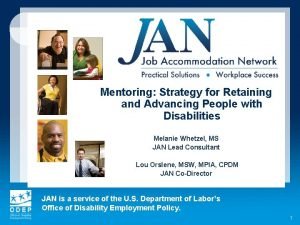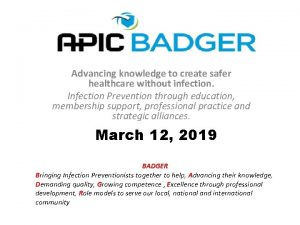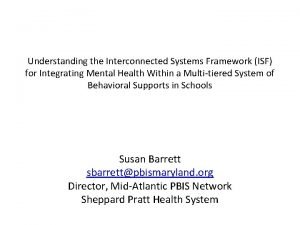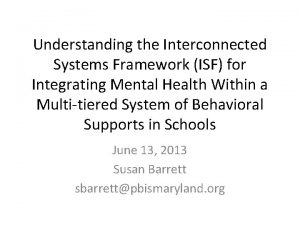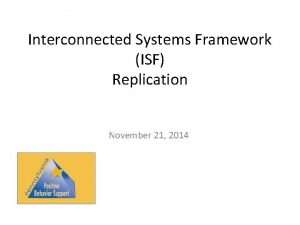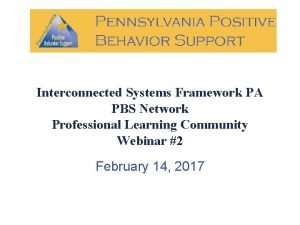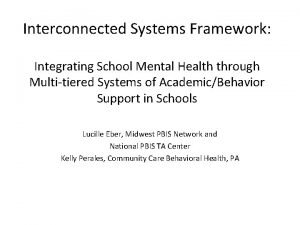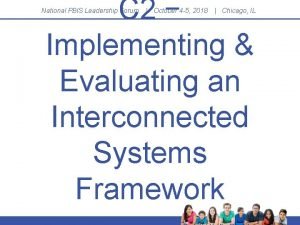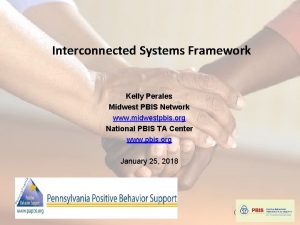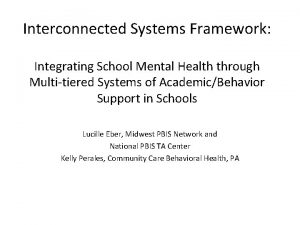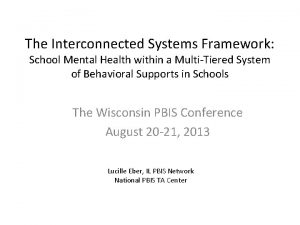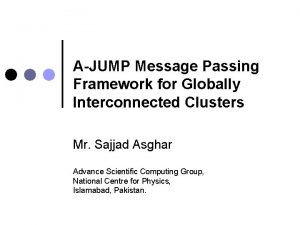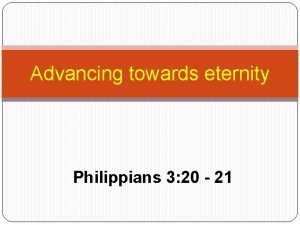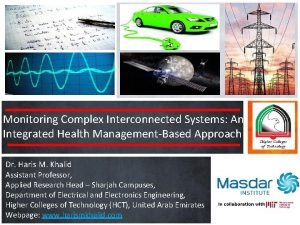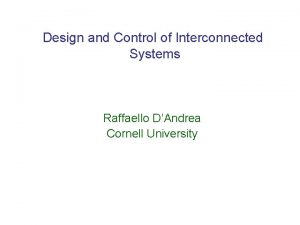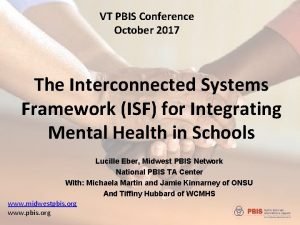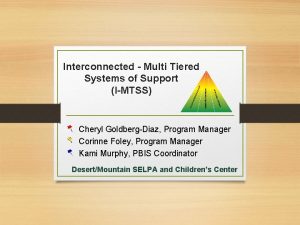Advancing Education Effectiveness The Interconnected Systems Framework ISF























































- Slides: 55

Advancing Education Effectiveness: The Interconnected Systems Framework (ISF) for PBIS and School Mental Health Northern CA PBIS Symposium November 18, 2013 Lucille. Eber@pbisillinois. org

Content: • Describe the features of an Interconnected Systems Framework (ISF) for Integrating Mental Health in Schools • Describe efforts and resources from blended efforts of National Centers to promote a broader continuum of evidence-based practices to support the mental health of all students • Describe emerging examples of ISF

Acknowledgements • • Susan Barrett & Mark Weist. Joanne Cashman- NASDSE(IDEA Partnership) Rob Horner & George Sugai – National PBIS TA Center Sharon. Stephens & Nancy Lever-National Center for SMH Jill Johnson-IL Kelly Perales- PA All the ISF Authors and participants

Some ‘Ah Ha’ moments… • Why expect teachers/principals to switch to proactive strength-based approach with the students deemed “the worst” when practices not being used for others? • Why ask them to build highly individualized plans from scratch one student at a time? • Was difficult because evidence-based behavioral approaches were not being used…

Need for Change? Special Education Sea of Ineligibility General Education

Bridging the Gap Amount of Resources Needed to Solve Problem General + Intensive Resources General + Supplemental Resources General Resources Intensity of Problem

Some “Big Picture” Challenges • Low intensity, low fidelity interventions for behavior/emotional needs • Habitual use of restrictive settings (and poor outcomes) for youth with disabilities • High rate of undiagnosed MH problems (stigma, lack of knowledge, etc) • Changing the routines of ineffective practices (systems) that are “familiar” to systems

Why Partnership Are Needed • One in 5 youth have a MH “condition” • About 70% of those get no treatment • School is “defacto” MH provider • JJ system is next level of system default • Suicide is 4 th leading cause of death among young adults • Factors that impact mental health occur ‘round the clock’ • It is challenging for educators to address the factors beyond school • It is challenging for community providers to address the factors in school • Potential partners must come together in a comprehensive system

BIG Idea… • How Multi-tiered Systems of Support (MTSS) can enhance mental health in schools • Installing SMH through MTSS in Schools • The Interconnected Systems Framework (ISF) SMH +MTSS=ISF

SCHOOL-WIDE POSITIVE BEHAVIOR INTERVENTIONS and SUPPORT 5% 15% Primary Prevention: School-/Classroom. Wide Systems for All Students, Staff, & Settings 80% of Students Tertiary Prevention: Specialized Individualized Systems for Students with High-Risk Behavior Secondary Prevention: Specialized Group Systems for Students with At-Risk Behavior

ISF Monograph Development June 2012 – September 2013 • Define the common goals of SMH and PBIS • Discuss the advantages of interconnection • Identify successful local efforts to implement collaborative strategies and cross-initiative efforts • Define the research, policy, and implementation agendas to take us to the next action level

Positive Behavior Intervention and Support (www. pbis. org) Decision making framework to guide selection and implementation of best practices for improving academic and behavioral functioning – Data based decision making – Measurable outcomes – Evidence-based practices – Systems to support effective implementation

SMH and PBIS Common Purpose • Schools supporting/promoting MH of ALL students • Prevention, early access, interventions commensurate with level of need (versus labeling with no or poor follow-up) • School personnel feel confident and competent in identifying and intervening with accuracy and effectiveness

Key Rationale • PBIS and SMH systems are operating separately • Results in ad hoc, disorganized delivery of SMH and contributes to lack of depth in programs at Tiers 2 and 3 for PBIS • By joining together synergies are unleashed and the likelihood of achieving depth and quality in programs at all three tiers is greatly enhanced

Logic Enhanced resources, staff and coordination of ISF help to build systems at all tiers Youth with challenging emotional/behavioral problems are generally treated very poorly by schools and other community agencies, and the “usual” approaches do not work

Logic, cont. • Effective academic performance promotes student mental health and effective mental health promotes student academic performance. The same integration is required in our systems

Development of ISF • 2002 -2007: Site Development with PBIS Expansion (informal and independent) • 2004: Co. P focus on integration of PBIS and SMH • 2009: First ISF White Paper • 2009 - 2013: Monthly calls with implementation sites, national presentations (from sessions to strands) • 2010 -2013: Grant Submissions • June, 2012 - September, 2013: ISF Monograph

Connections and Partnerships • OSEP National PBIS Technical Assistance Center (pbis. org) • Center for School Mental Health (csmh. umaryland. edu) • NASDSE (ideapartnership. org) • National COP for SBH (sharedwork. org)

Core Features of a Response to Intervention (Rt. I) Approach • Investment in prevention, screening and early intervention for students not at “benchmark” • Multi-tiered intervention approach • Use of progress monitoring and problemsolving process at all 3 -tiers

Core Features of a Response to Intervention (Rt. I) Approach • Research-based practices and active use of data for decision-making at all 3 -tiers • Use of progress monitoring and problemsolving process at all 3 -tiers

ISF Defined – ISF provides structure and process for education and mental health systems to interact in most effective and efficient way. – ISF is guided by key stakeholders in education and mental health system who have the authority to reallocate resources, change role and function of staff, and change policy. – ISF applies strong interdisciplinary, cross-system collaboration.

ISF Defined – ISF uses the tiered prevention logic as the overall organizer to develop an action plan. – ISF involves cross system problem solving teams that use data to decide which evidence based practices to implement. – ISF involves ongoing progress monitoring for both fidelity and impact. – ISF emphasizes active involvement by youth, families, and other school and community stakeholders.

Traditional • Each school works out their own plan with Mental Health (MH) agency; Preferred • District has a plan for integrating MH at all buildings (based on community data as well as school data);

Traditional • A MH counselor is housed in a school building 1 day a week to “see” students; Preferred • MH person participates in teams at all 3 tiers;

Traditional Preferred • No data to decide • MH person leads group or individual on or monitor interventions based interventions; on data;

Structure for Developing an ISF: A District/Community leadership that includes families, develops, supports and monitors a plan that includes: – Community partners participating in all three levels of systems teaming in schools: Universal, Secondary, and Tertiary – Team of SFC partners review data and design interventions that are evidence-based and can be progress monitored – MH providers from both school and community develop, facilitate, coordinate and monitor all interventions through one structure

Family and community Universal Team Plans SW & Class-wide supports Universal Support 3 -Tiered System of Support Necessary Conversations Family and community Community Secondary Systems Team Problem Solving Team Uses Process data; determines overall intervention effectiveness Standing team with family; uses FBA/BIP process for one youth at a time Tertiary Systems Team Uses Process data; determines overall intervention effectiveness CICO SAIG Group w. individual feature Brief FBA/BIP Sept. 1, 2009 Family and community Brief FBA/ BIP Complex FBA/BIP WRAP

Interconnected Systems Framework Tier I: Universal/Prevention for All Coordinated Systems, Data, Practices for Promoting Healthy Social and Emotional Development for ALL Students · School Improvement team gives priority to social and emotional health · Mental Health skill development for students, staff/, families and communities · Social Emotional Learning curricula for all · Safe & caring learning environments · Partnerships : school, home & community · Decision making framework guides use of and best practices that consider unique strengths and challenges of each school community

Interconnected Systems Framework Tier 2: Early Intervention for Some Coordinated Systems for Early Detection, Identification, and Response to Mental Health Concerns · Systems Planning Team coordinates referral process, decision rules and progress monitors · Array of services available · Communication system: staff, families and community · Early identification of students at risk for mental health concerns due to specific risk factors · Skill-building at the individual and groups level as well as support groups · Staff and Family training to support skill development across settings

Interconnected Systems Framework Tier 3: Intensive Interventions for Few Individual Student and Family Supports · Systems Planning team coordinates decision rules/referrals and progress monitors · Individual team developed to support each student · Individual plans have array of interventions/services · Plans can range from one to multiple life domains · System in place for each team to monitor student progress

MH/PBIS: An Expanded Tier One • Broader range of Data – Opportunity to review community data and expand Tier 1 intervention options based on data • Universal screening – for social, emotional, and behavioral at-risk indicators – for families who may request assistance for their children • Teaching – social skills with evidence-based curricula to all students – appropriate emotional regulation and expression to all students – behavioral expectations to all students

School Data Community Data Student and system level • Academic (Benchmark, GPA, Credit accrual etc) Discipline Attendance Climate/Perception Visits to Nurse, Social Worker, Counselor, etc • Screening from one view • • • Community Demographics • Food Pantry Visits • Protective and Risk Factors • Calls to crisis centers, hospital visits • Screening at multiple views

MH/PBIS: An Expanded Tier Two • Mapping of all existing interventions to ensure key resources are aligned to ensure both efficiency and effectiveness (“bully prevention”, “discipline”, “character education”, “Rt. I behavior”, etc. ) • Groups co-facilitated by school staff and community partner (example – guidance counselor and community provider clinician) • Opportunity to expand the continuum of interventions based on data (i. e. trauma informed interventions) • Out-reach to families for support/interventions

MH/PBIS: An Expanded Tier Three • Quicker access to a richer continuum ofcommunity-based supports for students and families • FBA/BIP and/or person-centered wraparound plans completed together with school staff and mental health provider for one concise plan, rather than each ‘completing paperwork to be filed’

A District Example

IL District U-46 at a Glance: 2012 -2013 Enrollment: § § § Total school enrollment 40, 570 54. 8% Low Income 97 languages spoken in U-46 homes Facilities: § § 40 Elementary Schools (Pre. K-6) 8 Middle Schools (7 -8) + 1 Alternative Middle School 5 High Schools + 2 Alternative High Schools 2 Early Childhood Centers Communities Served: § § 11 communities 3 counties (Cook, Du. Page, Kane)

20 Community Partners 57 providers trained in PBIS/SAIG Boys and Girls Club of Elgin*Centro de Informacion* Community Crisis Center*Crossroads Kids Club* Easter Seals*Elgin Police Department* Family Service Association of Greater Elgin Area*Fox Valley Pregnancy Center*Fox Valley Volunteer Hospice*Girl Scouts of Northern Illinois*Hanover Township Youth and Family Services*Kenneth Young*Renz Center*Streamwood Behavioral Healthcare System*Taylor Family YMCA*The Y*WAYS*West Ridge Community Church*Youth Leadership Academy

U-46 School and Community Alliance Work Groups 2009 -2012 Operations Tier 2/3 High School Violence Prevention

Tier 2/3 Work Group Outcomes § Creation of Guidelines for Schools and Agencies Working Together § Agency Partners are active members of Secondary Systems Teams (9) § Trained Agency Partners in Social Academic Instructional Groups/DPR Data § 25 partners are sitting on teams and/or providing SAIG in schools § Use of the DPR (Daily Progress Report) for progress-monitoring

G. Elementary Major ODRs per 100 Students 100 90. 31 80 60 44. 88 50. 40 44. 57 40 2009 -10 2010 -11 2011 -12 Major ODRs per 100 students 2012 -13

G. Elementary Students with 6+ ODRs 6. 00% 5. 00% 4. 85% 4. 00% 3. 00% 2. 00% 1. 97% 1. 79% 1. 74% 2010 -11 2011 -12 2012 -13 1. 00% 0. 00% 2009 -10 Students with 6+ ODRs

CO Elementary OSS Events and OSS Days 40 38 35 30 25 20 15 15 17 10 10 5 0 2009 -10 2012 -13 OSS Events OSS Days

C-O Elementary Students with 6+ ODRs 1. 20% 1. 13% 1. 00% 0. 80% 0. 60% 0. 40% 0. 19% 0. 20% 0. 00% 2009 -10 2012 -13 Students with 6+ ODRs

PBIS + Positive Youth Development Key elements to the Youth Development approach are the following: § Youth are viewed as a valued and respected asset to society; § Policies and programs focus on the evolving developmental needs and tasks of adolescents, and involve youth as partners rather than clients; § Families, schools and communities are engaged in developing environments that support youth; § Adolescents are involved in activities that enhance their competence, connections, character, confidence and contribution to society; § Adolescents are provided an opportunity to experiment in a safe environment and to develop positive social values and norms; and § Adolescents are engaged in activities that promote selfunderstanding, self-worth, and a sense of belonging and resiliency.

E. High School Example Social Academic Instruction Groups (SAIG) Coordinated by EHS Counselor Facilitated by Community Partner Data: Feedback from Teachers and Students Groups 6 -8 weeks Students grouped based on teacher feedback and lack of response to CICO § Agency partner is active member of secondary systems team § § §

Weekly Progress Report: Earn and Give Respect (student will not talk back to staff) Hold Yourself Responsible (Student will be on time to class) Safety First (Student will wear ID around neck)

I feel connected to my school Pre-Test Post-Test Strongly Disagree Neither Agree nor Disagree Agree Strongly Agree 22% 33% 44% 11% 11% 22%

I feel respected and important while at school Pre-Test Post-Test Strongly Disagree Neither Agree nor Disagree Agree Strongly Agree 11% 33% 22% 67% 33%

Next Steps for Alliance… Increase Trauma focus at all three tiers Directory of partners/agencies Blend initiatives/coordinate across the district Alternative to suspension expansion Utilize exemplars in district as examples for other schools § Increase communication/visibility of Alliance § § §

Closing thoughts………

Problem • Innovative practices do not fare well in old organizational structures and systems • Organizational and system changes are essential to successful use of innovations – Expect it – Plan for it © Dean Fixsen, Karen Blase, Robert Horner, George Sugai, 2008

The Need to Be Plan-ful: Implementation occurs in stages: • • • Exploration-Adoption Installation Initial Implementation Full Implementation Innovation Sustainability Fixsen, Naoom, Blase, Friedman, & Wallace, 2005 2 – 4 Years

Problem • Students cannot benefit from interventions they do not experience © Dean Fixsen, Karen Blase, Robert Horner, George Sugai, 2008

Ensuring Systems are Ready

Social Competence & Academic Achievement OUTCOMES ST SY TA Adapted from “What is a systems Approach in schoolwide PBS? ”OSEP Technical Assistance on Positive Behavioral Interventions and Supports. Accessed at http: //www. Pbis. org/schoolwid e. htm DA Supporting Staff Behavior EM S Positive Behavior Support PRACTICES Supporting Student Behavior Supporting Decision Making
 Advancing education effectiveness
Advancing education effectiveness Multi tiered system of supports
Multi tiered system of supports Isf software
Isf software Importer security filing form template
Importer security filing form template Isf filing deadline
Isf filing deadline It means making use of all the personal resources
It means making use of all the personal resources Sales performance management framework
Sales performance management framework Personal effectiveness framework
Personal effectiveness framework Efficiency and effectiveness in higher education
Efficiency and effectiveness in higher education Internet merupakan jaringan
Internet merupakan jaringan Chapter 10 business in a global economy
Chapter 10 business in a global economy Set of interconnected components
Set of interconnected components Osi vs tcp/ip
Osi vs tcp/ip Too interconnected to fail
Too interconnected to fail Consider three lans interconnected by two routers
Consider three lans interconnected by two routers Interconnected computer networks that
Interconnected computer networks that They relay packets among multiple interconnected networks
They relay packets among multiple interconnected networks 10 steps to advancing college reading skills
10 steps to advancing college reading skills Ten steps to advancing college reading skills
Ten steps to advancing college reading skills Ronald lee in advancing
Ronald lee in advancing Advancing vocabulary skills 4th edition answer key
Advancing vocabulary skills 4th edition answer key Ten steps to advancing college reading skills
Ten steps to advancing college reading skills Advancing colours
Advancing colours Ieee advancing technology for humanity
Ieee advancing technology for humanity Chapter 11 sentence check 2 clandestine
Chapter 11 sentence check 2 clandestine Advancing vocabulary skills 4th edition
Advancing vocabulary skills 4th edition Ten steps to improving college reading skills 6th edition
Ten steps to improving college reading skills 6th edition Mounts classification
Mounts classification Advancing vocabulary skills 4th edition
Advancing vocabulary skills 4th edition Advancing vocabulary skills 4th edition
Advancing vocabulary skills 4th edition Learning is like rowing upstream meaning
Learning is like rowing upstream meaning Advancing technology for humanity
Advancing technology for humanity What is advancing loan
What is advancing loan Advancing vocabulary skills 4th edition
Advancing vocabulary skills 4th edition Advancing healthcare research
Advancing healthcare research Ten steps to advancing college reading skills
Ten steps to advancing college reading skills Gilead advancing access
Gilead advancing access Ten steps to building college reading skills
Ten steps to building college reading skills Mentoring best practices
Mentoring best practices Advancing technology for humanity
Advancing technology for humanity Advancing knowledge in healthcare
Advancing knowledge in healthcare Dispositional framework vs regulatory framework
Dispositional framework vs regulatory framework How to make theoretical framework
How to make theoretical framework Franmework
Franmework Conceptual framework theoretical framework
Conceptual framework theoretical framework Dispositional framework vs regulatory framework
Dispositional framework vs regulatory framework Theoretical framework example
Theoretical framework example Hát kết hợp bộ gõ cơ thể
Hát kết hợp bộ gõ cơ thể Slidetodoc
Slidetodoc Bổ thể
Bổ thể Tỉ lệ cơ thể trẻ em
Tỉ lệ cơ thể trẻ em Voi kéo gỗ như thế nào
Voi kéo gỗ như thế nào Tư thế worms-breton
Tư thế worms-breton Chúa yêu trần thế
Chúa yêu trần thế Môn thể thao bắt đầu bằng chữ f
Môn thể thao bắt đầu bằng chữ f Thế nào là hệ số cao nhất
Thế nào là hệ số cao nhất
